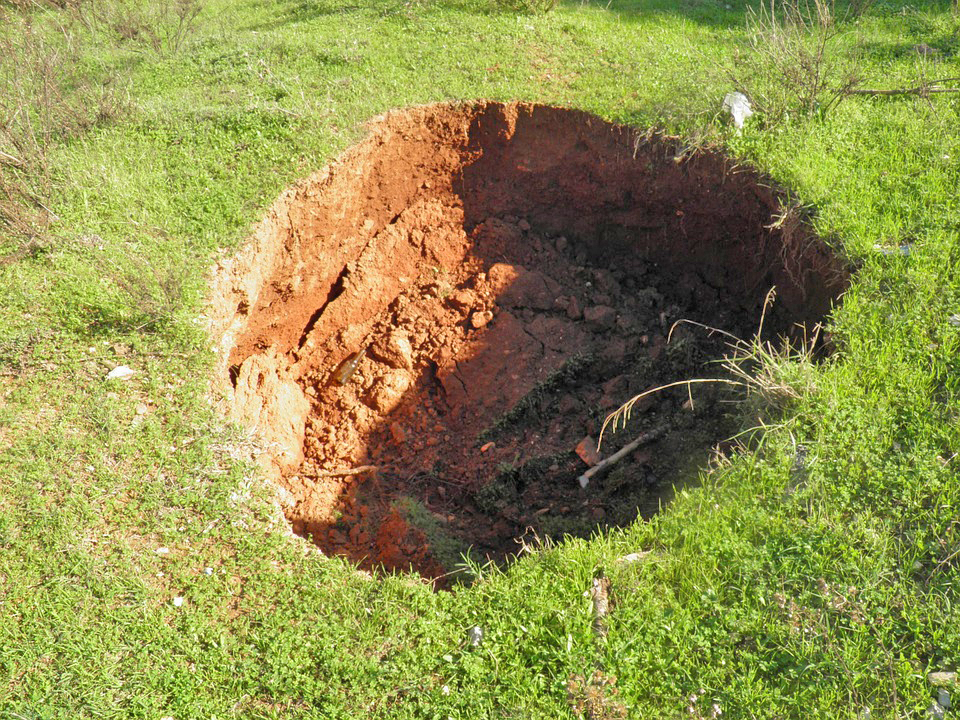Aging waste and sewer systems causing sinkhole effect
A hole in the ground can be a bad thing for rolling wheels and moving feet. These burrows, potholes, divots, manholes, ground tunnels and ditches could cause issues if they are overlooked, but when the Earth suddenly gives way and a large land-mass collapses, the level of danger and damage can be much more detrimental and harder to avoid. These sinking sensations are called sinkholes and they can happen naturally or with help from humans, and the cost of repair can run into the millions for states, cities and counties.
A natural sinkhole occurs in “karst terrain,” which means the type of rock, called evaporites, below the land surface can naturally be dissolved by groundwater circulating through them. When rain water moves down through the soil, these types of rock begin to dissolve and spaces and caverns develop underground. When a sinkhole occurs, it is normally massive because the land will stay intact for a period of time until the underground spaces get too big and there is not enough support anymore for the top layer of land. The ground could collapse suddenly or cave in gradually over time. Sinkholes occur more frequently after intense rainfall, but there is some evidence that drought can cause this phenomenon. Areas where water levels have lowered suddenly are more prone to collapse formation.

Man-made sinkholes caused by a human, or anthroprogenic, can occur in any state under the wrong conditions. There have been more than 20 ground collapses in the last two decades in Asheville, N.C. Nearly all of these land cave-ins were caused by underground pipe failures. One of the sinkholes has been gradually swallowing up two homes, forcing tenants out and making them unlivable. In December, a $5.6 million stormwater utility fund paid for annually by Asheville property owners was used to replace 2,500 feet of pipes to drain away rain water.
In Michigan, a sewer pipe collapse led to a 100-foot wide by 200-foot long sinkhole in Fraser. The December 2016 incident put 11 municipalities that pay for the sewer system on the hook to cover repairs. The sinkhole forced evacuations of 22 homes. Occupants in 19 of the homes have returned, but two of them have been condemned and demolished. Repairs are estimated to cost around $75 million and the Washington Township, who owns just under 3 percent of the system, will put forth $2 million towards the repair cost. The city of Sterling Heights is protesting against its $22 million portion of the tab. Lt. Gov. Brian Calley announced that a $3 million state grant would help repair the sinkhole. The funding supplemented a $2 million grant from the Michigan Department of Environmental Quality.
In January, a sinkhole in Cheltenham, Pa., swallowed a vehicle, a tree, a driveway, sidewalks, part of two front lawns and eventually claimed two homes. Emergency responders were unsure whether the sinkhole was due to natural causes or from a water main brake.
In February, a water main break flooded several streets in Hoboken, N.J., causing an elementary school to shut down and forming a sinkhole that swallowed an entire sports utility vehicle.
Last week a 13-foot by 20-foot sinkhole, likely caused by a failed irrigation pipe, shut down both lanes of traffic on 11th Avenue in Hanford, Calif. Old corrugated metal pipes that have rusted away have caused other road sinkholes in the Hanford area in recent months. A 30-year-old metal culvert passing under a county highway and old roads caused two road collapses a couple of weeks ago in Wausau, Wis.
Sewer pipes can become compromised in different ways over time. Small cracks or fractures can occur in old pipes, or misalignments can occur at a connection point. These openings can be tiny but still allow small amounts of dirt to sift into the pipe. That dirt is carried away with the wastewater, but over time, enough soil from above the pipe is flushed away that a hollow space can form above the pipe and below the street surface. If enough soil quietly sifts into the sewer, and a big enough void forms below the street’s concrete, the surface may no longer be able to support its own weight, and collapses into that subterranean space. This can happen suddenly, or gradually.
The Environmental Protection Agency estimates that at least 23,000 to 75,000 sanitary sewer overflow events occur in the United States each year and that around $271 billion is needed for wastewater infrastructure over the next 25 years. While the federal government provides some funding through the Clean Water State Revolving Fund, according to the U.S. Conference of Mayors, 95 percent of spending on water infrastructure is made at the local level. Cities and towns across the country report that complying with federal wastewater and stormwater regulations represents some of their costliest capital infrastructure projects. The majority of treatment facility expenses are supported by rate payers, however rising utility bills can present affordability issues. In a 2014 survey of the nation’s 50 largest cities, average monthly sewer bills ranged from $12.72 in Memphis to $149.35 in Atlanta.
The opportunities for water and sewage system repairs and replacements won’t be slowing down anytime soon for states like Oklahoma. The Oklahoma Water Resources Board recently approved a $27.36 million loan the city can use to fund wastewater and stormwater infrastructure projects and purchase equipment needed to maintain their system. The low-interest loan will be financed through the Oklahoma Clean Water Revolving Fund, a program administered at the federal level by the U.S. Environmental Protection Agency in partnership with the states.
City councilors in March approved the long-range infrastructure plan, which includes the repair or replacement of infrastructure that is 100 years old or older. Planned sewer and stormwater improvements include repairs to several sewage lift stations, upgrades to collection lines within certain basins, wastewater treatment plant improvements and Civitan Basin stormwater drainage improvements. Most of those projects address problems identified in a consent order issued by the Oklahoma Department of Environmental Quality in response to past violations.
In Pennsylvania, an analysis of Carlisle Borough’s water distribution system recommends the borough begin a replacement program on its 86 miles of water mains that could cost up to $2 million per year and take decades to complete. The borough took over the water system during the 1940s. It has no records for the system prior to the acquisition. That means the age of some of the mains is unknown, but could date back more than 100 years. The study recommended that 1.5 to 2 miles of mains be replaced yearly. At that rate, it would take 40-55 years to replace all of the mains.
An independent study performed on the water and sewer system in Fort Lauderdale, Fla., found that the city’s system to deliver drinking water from the tap, and to carry away sewage, has aging parts that could fail at any time. This 106-year-old city could be looking at $1.4 billion worth of repairs. In November, voters countywide defeated a sales tax increase for improvements that could have helped cities like Fort Lauderdale rebuild aging systems. The water-sewer system serves hundreds of thousands, reaching beyond Fort Lauderdale’s borders. The city paid $1.9 million for a consultant to review the water and sewer system. The review was completed in April, but information has not been disclosed on the findings.
SPI’s government contracting consultants have decades of experience and personal relationships at all levels of government. Learn how they can help your company grow your business by contacting them today.

 512-531-3900
512-531-3900 Request More Info
Request More Info